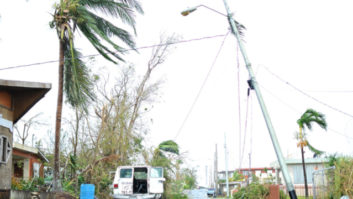To paraphrase Mark Twain, “The report of AM’s illness grew out of radio’s illness. The report of AM’s death was an exaggeration.”
AM is quite alive and vital today. It may have been relegated to the programming backwaters in some places, but in the central United States it still remains the primary source of essential information for many people.
I am from an area that literally lives and dies by the current and impending weather as well as the commodity markets. This is not only the trading of commodity stocks, but what the producer receives when he sells to a receiving terminal at a given time. AM radio gives people this up-to-the-minute information that is not easily accessible from any other source.

R. V. Zeigler. ‘There is no better way to get vital information to the greatest number of people, over the broadest coverage area, in the shortest amount of time than live AM broadcast radio.’ Wireless hot spots for the laptop while you are checking cattle or in the dusty cab of a combine while harvesting grain? Not very likely! Cell phone coverage? To an extent, but the further you get from interstate highways or population centers the spottier the coverage becomes.
So what provides the necessary information to these areas? The old-fashioned AM broadcast band that people have grown to love and trust.
People in rural Nebraska desired it to the extent that more than 4,000 of them came together and formed a broadcast company in 1951 to give them the information they need and want, still today. This is who I work for, and the listener-owners are not shy about letting us know if we are not giving them the information they need.
I am also pleasantly surprised that they are equally willing to tell us when we do things to their satisfaction. Few things give you that “feel-good” sensation such as when you are approached in public and told how well someone likes what the station is doing. Not a ploy to get “swag,” but genuine appreciation of the job we do for them.
This part of the U.S. also has many main transportation routes going through it. Comprehensive, accurate and up-to-the-minute weather reports are vital to the safety of the people and the goods using these arteries of commerce.
AM radio, once again, is the best medium to disseminate this information.
Godsend
I had to travel one day in unknown territory during flooding conditions. Finding a regional AM station that gave timely information about road closures was a godsend.
This happened during a weekend, and the majority of the local stations stayed with their formats, hardly mentioning the problems in the area. There were the generic high and low temperatures and chance-of-rain “weather forecasts,” but few were breaking in with information that was helpful.
It was painfully obvious that few stations were even staffed, which is another reason that radio in general, AM in particular, might seem irrelevant to some.
This small incident was a glimpse of what was to happen on a much larger scale when Katrina destroyed our Gulf coast region.
People were displaced from their homes and businesses, then left to fend for themselves in a chaotic situation. Cell phones became useless, Internet connections were nonexistent and quite a few broadcasters were silenced due to a number of factors. However, AM radio, from stations outside the directly affected area, was able to get lifesaving information to those who had been affected.
This is the reason that small battery- or crank-operated radios are among the emergency supplies passed out by responding agencies.
There is no better way to get vital information to the greatest number of people, over the broadest coverage area, in the shortest amount of time than live AM broadcast radio.
This is also why, many years ago, government agencies set up a network of cooperating AM broadcast facilities across the nation for use in time of national emergency. These stations, with their broad coverage areas, can provide information directly to the vast majority of the national landmass whenever needed.
This information can be received on inexpensive, simple receivers powered by a multitude of sources, and require no subscription fees or local infrastructure.
I would like to suggest the following to any broadcasters who have AM stations in the larger over-served markets, especially those of you who have publicly questioned the viability or necessity of AM: Please consider darkening your AM and turning in your license. This would save you the large, ongoing expenses and let you concentrate on your more profitable properties. It would also allow those of us outside of those areas to expand our AM coverage and serve our listeners to an even greater degree.
AM dead? No! It is a vital and important medium of communication to a large part of the country and will continue to be for the foreseeable future; and I am quite proud to be associated with it.
Rod Zeigler is director of engineering for Nebraska Rural Radio Association in Lexington, Neb. Stations are KNEB(AM/FM) in Scottsbluff, KTIC(AM/FM) in West Point, and flagship KRVN(AM) and sister station KRVN(FM) in Lexington.











